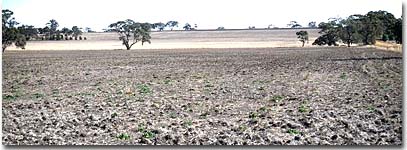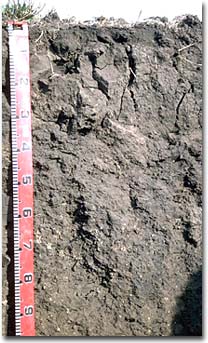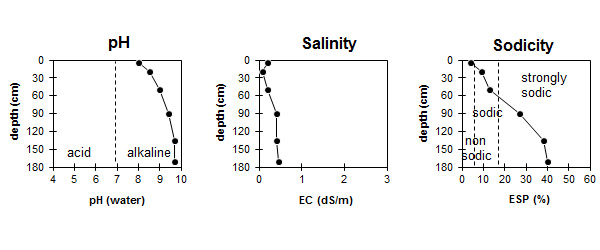LS7
Location: Diapur
Australian Soil Classification: Epicalcareous-Endohypersodic, Epipedal, Grey VERTOSOL
Northcote Factual Key: Ug 5.2
Great Soil Group: grey clay
General Landscape Description: Level clay plain.
Native Vegetation: Black Box (Eucalyptus largiflorens) in undisturbed areas.
 LS7 Landscape |
Soil Profile Morphology:
Surface Soil
| A1 | 0-10 cm | Dark grey (10YR4/1); medium clay; strong fine blocky structure; weak consistence dry; a slight sporadic bleach occurs at the base of this horizon in patches; pH 8.0: |  LS7 Profile |
| Subsoil | |||
| B21 | 10-30 cm | Grey (10YR5/1); medium heavy clay; moderate coarse prismatic structure (with conchoidal fracturing evident); strong consistence dry; pH 8.5: | |
| B22 | 30-70 cm | Grey (10YR5/1); heavy clay; strong polyhedral structure; pH 9.0; gradual and wavy boundary change to: | |
| B23 | 70-110 cm | Greyish brown (10YR5/2); medium heavy clay; structure as above; contains few (2 - 5%) soft and hard carbonate segregations; pH 9.4: | |
| B24 | 110-160 cm | Yellowish brown (10YR5/4); medium heavy clay; strong prismatic, parting to strong polyhedral structure; contains very few (2%) soft and hard carbonate segregations; pH 9.7: | |
| B25 | 160+ cm | Light grey (2.5Y7/2); medium clay with a diffuse reddish brown mottle; moderate coarse lenticular structure. | |
Key Profile Features:
- Clay texture throughout profile.
- Significant cracking occurs when soil is dry. Cracks usually occur at the surface as well as at depth.
- Vertic properties (ie. strong shrink-swell potential).
Soil Profile Characteristics:
pH | Salinity | |||
Surface (A1 horizon) | Moderately Alkaline | Very Low | Non-Sodic | Sslaking, No Dispersion |
Subsoil (B21 horizon) | Moderately Alkaline | Very Low | Sodic | Slight-Moderate |
Deeper Subsoil (at 1 metre) | Very Strongly Alkaline | Low-Medium | Strongly Sodic | Strong |

| The surface and upper subsoil is moderately alkaline. The subsoil is very strongly alkaline. | The salinity rating is very low in the surface and upper subsoil becoming moderate with depth. | The surface is non-sodic. The subsoil is sodic becoming strongly sodic at depth. |
Chemical and Physical Analysis:
Horizon | Horizon Depth (cm) | pH (water) | pH (CaCl2) | EC dS/m | Exchangeable Cations | |||
Ca | Mg | K | Na | |||||
meq/100g | ||||||||
A1 | 0-10 | 8.0 | 7.3 | 0.2 | 26 | 6.6 | 2.1 | 1.4 |
B21 | 10-30 | 8.5 | 7.2 | 0.09 | 18.6 | 8.5 | 1.4 | 2.6 |
B22 | 30-70 | 9.0 | 7.9 | 0.19 | 14 | 8.1 | 1.5 | 3.5 |
B23 | 70-110 | 9.4 | 8.5 | 0.42 | 11.5 | 9.6 | 1.7 | 8.2 |
B24 | 110-160 | 9.7 | 8.6 | 0.42 | 7.7 | 11.2 | 1.7 | 12.5 |
B25 | 160+ | 9.7 | 8.8 | 0.45 | 8.4 | 10.7 | 1.5 | 13.7 |
Horizon | Horizon Depth (cm) | Oxidisable Organic Carbon % | Total Nitrogen % | Field Capacity pF2.5 | Wilting Point pF4.2 |
A1 | 0-10 | 1.4 | 0.17 | 40 | 27 |
B21 | 10-30 | 0.7 | 0.1 | 44 | 32.2 |
B22 | 30-70 | 0.7 | 0.07 | ||
B23 | 70-110 | ||||
B24 | 110-160 | ||||
B25 | 160+ |
Management Considerations:
Surface (A) Horizon
- The surface soil has a very high inherent fertility (based on the sum of the basic exchangeable cations); a moderate level of organic carbon and relatively high total nitrogen levels. Cracking clay soils tend to readily mineralise nitrogen in bare fallows but total nitrogen levels are rapidly diminished under cropping.
- When the soil is dry, water from heavy rains will move down soil cracks. This rapid recharge can be valuable for the survival of plants near wilting point. When wet, the soil will swell and further infiltration of water will be relatively slow.
- The very high wilting point (ie. 27%) for the clayey surface horizon means that plants will not be able to fully utilise light rains falling on relatively dry soil.
- The sodic and dispersive subsoil is likely to restrict water and root movement. Dispersion at the top of the subsoil is probably reduced by the favourable exchangeable calcium:magnesium ratio (ie. 2.2).
- The top of the subsoil shows signs of structural degradation, possibly due to excessive cultivation in a moist condition. This is evident from the conchoidal ("ball and cup") fracturing and associated dull fracture faces which have been caused by aggregates being pressed into each other. Tillage of cracking clay soils should be avoided if the soil is wet (ie. wetter than the plastic limit). At such moisture conditions, tillage and excessive trafficking or overstocking could result in structural damage (e.g. compaction, smearing) occurring. Ideally tillage should take place when the soil is drier than the plastic limit down to at least the tillage depth.
- The compacted upper subsoil will restrict root movement into the subsoil. The soil will eventually "self-repair" due to its shrink swell properties, as long as compaction is avoided when the soil is wetter than the plastic limit.
- Legume/barley/fallow/wheat rotation used.
- Superphosphate, Grain Legume Super and Mallee Mix 4 applied.
- Prone to waterlogging.


